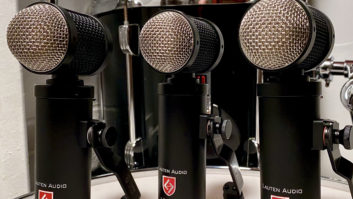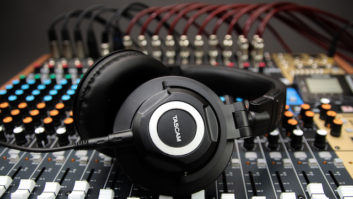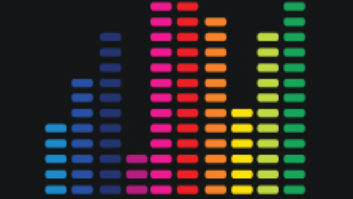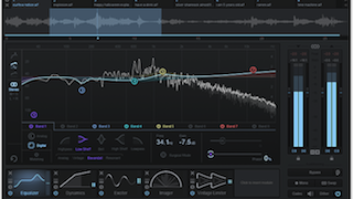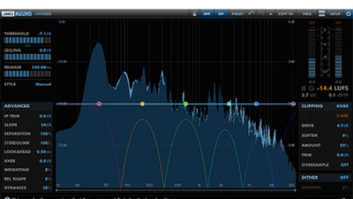It’s great when you find things that make your life easier, things that become such a part of your day-to-day world that it’s hard to think of your life without them. Problem solvers needn’t be expensive or expansive.
For example, at Blackbird we started using Cable Cuff Pro to keep longer speaker and instrument cables together. It’s always a pain to wrangle 25-foot-plus runs of cable used to isolate speaker cabinets or make long instrument runs to a combo amp from a guitar station or control room. These inexpensive organizers make it easy to store, hang and work with long lines. They come in many sizes and have a ratchet and pushbutton release—kind of like the toy handcuffs you had as a kid, but without the chain. You can get them online or at most home stores.
Lumit is a new DAW inspired by Berklee students and just released at NAMM. Another DAW, you say? You never know! Lumit ($149) is now 32-bit, but a 64-bit version is in the works. It supports ASIO, ASIO4ALL, Direct Sound, MME, and WASAPI drivers, and offers full audio, MIDI and automation recording, plus sequencing and VST3/i plug-ins. As with many predecessors, there is a complete mixing console and waveform display, and it operates at up to 192kHz/32-bit float. It works on a laptop or, more importantly, fully on a tablet (hello future) with multi-touch hand gestures and a dynamic GUI that handles any resolution from 1280×720 and up. It comes with more than 1k of synth, percussion, and bass samples, and an audio DSP FX suite.
Never to be outdone, at NAMM, Apple’s Xander Soren gave me a one-on-one demo of their Music Memos app, and it is incredible (and free). Xander put his phone on the table, pressed Record on the app and played a song on the guitar. Music Memos analyzed the song, outlining the changes, and added drums and bass upon the first playback. Xander’s playing was tight, but if you slow down, or alter the arrangement with a breakdown, rubato ending or the like, the band follows. From here you can name the track, rate it using the familiar star system, and leave it at that. Or, you can take it up a notch or 10 by importing it into Logic Pro X or GarageBand on your iPad or laptop. From there you can change the personality of the players (styles), create a chart for musicians, and add tracks. For music creators, this is a must-have tool that is always with you on your phone ready to capture ideas. It’s free, and a no-brainer.
AudioNamix is a new software company from France that offers a range of tools, including ADX Trax and ADX Trax Pro, Vocal Volume Control, and DJ Voxchanger. It took me awhile to get my head around this powerful tool, but when Austin Seltzer, one of my students, asked me for a solution to an audio problem he was having, the light bulb went on. He was readying a mix for radio and had to remove two words NSFW. He couldn’t get the tracks back and had to find a way to fix the problem from the submitted mix, so I told him about the software. From Austin: “With ADX TRAX Pro I was able to remove just the offending words from the stereo mix without harming the instruments and ambience surrounding the vocal. ADX TRAX Pro analyzes your entire song, then separates the lead vocal for editing. Then the process menu tab takes you to a spectral analysis editor where you can remove the last bit of vocals from the instrumental, ensuring the best separation from the track.” Austin was impressed, was able to save the day and the song made it to the airwaves sounding great. On a side-note, Austin is now working for CLA (I like to brag about my kids).
Ever wondered about getting IEMs but thought the process with the self-applied ear goop or the expense of hiring a pro to do it was too daunting? Ultimate Ears plans on changing that. They are taking the process of getting an impression of your ear canal horizontal, meaning you can go to your local GC or other outlet and have it done there using a simple, hand-held digital scanner. The process is painless, goop-less and easy. They had 30 stations at NAMM spread over three booths on the floor taking free digital ear impressions to all comers. But that’s not my favorite part. Their new UE Pro Reference Remastered high-resolution IEMs created in collaboration with Capitol Studios are incredibly good. The new drivers blow the lid off the bandwidth, both high and low, from their first iteration. They are worth checking out as a second, third or fourth, trusted listening option when mixing.
These are just some of the problem solvers that have crossed my path in the last month or two. In my travels, interaction with audio pros at work, and exposure to new gear, I’ll be writing about these from time to time—watch for it.
